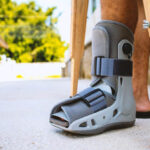A stress fracture in foot is not just an injury for athletes—it’s a condition that can affect anyone who places repetitive force on the bones of the foot. These small cracks, also called microfractures, often go unnoticed at first, but they can progress to more serious bone fractures if ignored. Understanding what is a stress …
A stress fracture in foot is not just an injury for athletes—it’s a condition that can affect anyone who places repetitive force on the bones of the foot. These small cracks, also called microfractures, often go unnoticed at first, but they can progress to more serious bone fractures if ignored. Understanding what is a stress fracture in the foot, how it develops, and how to treat stress fracture in foot injuries is essential for protecting your mobility and preventing long-term complications.
What is a stress fracture in the foot
A stress fracture in foot is a fine break in a weight-bearing bone caused by repetitive activity rather than a single traumatic event. These injuries occur when the bone’s natural repair process cannot keep up with the repeated stress, leading to a small crack that may worsen without proper care. Common causes include overuse, improper technique, sudden increase in activity, and worn footwear.
Athletes and individuals with physically demanding jobs are especially vulnerable to stress fractures. Research suggests these injuries account for roughly one-fifth of all sports-related injuries, highlighting just how common they are in active populations.
How a stress fracture differs from a sudden break
An acute fracture or bone break happens instantly, often from a fall or direct impact. In contrast, a stress fracture develops gradually due to repetitive force and is often the result of overuse injuries. Early symptoms may be mild, but without intervention, the stress reaction can progress into a complete fracture requiring surgical intervention.
Common bones involved: metatarsals, navicular, calcaneus
The most commonly affected bones include the metatarsal bones (especially the second and third metatarsals), navicular, and calcaneus (heel bone). These areas are at higher risk because they absorb the majority of impact during weight bearing activities. The fifth metatarsal base and talus bones are also vulnerable, particularly in athletes and those with bone insufficiency or osteoporosis.A stress fracture in foot can also develop when someone changes their routine, such as starting a new sport, ramping up workout intensity too quickly, or moving between different training surfaces like treadmill running and outdoor pavement. In people with weakened bones from conditions like osteoporosis, even normal daily activities may be enough to trigger a fracture.
Stress fracture symptoms you should not ignore
Recognizing the early signs of a stress fracture in foot can help prevent the injury from worsening. Delaying care may lead to callus formation at the fracture site, prolonged pain, and extended recovery time.
Pinpoint pain with activity, relief at rest, swelling, tenderness, possible bruising
Patients often report point tenderness at the site of the fracture, swelling, and sometimes bruising. Pain usually worsens during weight bearing activities such as running or walking and improves with rest. These symptoms make it clear why stress fractures are among the most frequently overlooked foot fractures, they can be mistaken for mild sprains or muscle strains.
Pain that starts late in workouts and begins earlier over time
In the early phase, discomfort may only appear near the end of physical activity. Over time, the pain starts earlier, eventually appearing even with light walking. This gradual shift in pain pattern is a hallmark of what is a stress fracture in the foot and signals the need for evaluation by an orthopedic foot specialist.
When to see a doctor vs home care
If you suspect a stress fracture in foot, knowing when to seek medical help is critical for avoiding complications like bone insufficiency or chronic pain.
Call a provider if pain persists, occurs at night, or with rest
Persistent pain, especially if it occurs at night or while resting, is a red flag. Early intervention allows for non-weightbearing immobilization or orthotics to prevent worsening. A visit to an orthopedic foot and ankle surgeon ensures a precise treatment plan.
Go to urgent care or ER for severe pain, deformity, or inability to bear weight
Severe pain, visible deformity, or complete inability to bear weight may mean your injury has progressed to a full fracture. In such cases, urgent care may involve walking boot use, fracture brace, or even surgical stabilization with pins and screws.
How stress fractures are diagnosed
Accurate diagnosis is key to developing an effective plan for how to treat stress fracture in foot cases.
Exam and risk review, focal tenderness over the bone
A full medical work-up includes a physical exam for tenderness to touch over the fracture site, review of activity history, footwear assessment, and consideration of risk factors like nutritional deficiencies, eating disorders, or the female athlete triad.
Imaging: X-rays often normal early, MRI is most accurate
Early x-rays may not show the fracture, making MRI scan the gold standard for early detection. CT scan or bone scans may be used in complex cases, such as fractures in the navicular or talus, where blood supply is limited and healing can be slower.
How to treat a stress fracture in the foot
Effective treatment focuses on rest, protection, and gradual return to activity under medical guidance.
Protection and rest: boot, stiff-soled shoe, crutches as needed
Protective footwear such as a walking boot or stiff-soled shoe reduces stress on the injured bone. In severe cases, crutches or non-weightbearing immobilization may be necessary. Healing typically takes 6–8 weeks, but bones with limited blood supply, like the navicular or fifth metatarsal base, may take longer. Learn more about foot fracture treatment in Brookfield, Wisconsin.
Ice and elevation for swelling
Apply a cold pack or ice for 15–20 minutes every few hours to control swelling. Elevating your injury above heart level can speed up swelling reduction. Always discuss pain relief with your doctor; while NSAIDs can reduce pain, some studies suggest they may slow bone healing.
Return to activity and prevention
Recovery from a stress fracture in foot doesn’t end when the pain subsides. Prevention strategies are key to avoiding repeat injuries.
Gradual return once pain free
Most patients can return to low-impact activities like swimming or cycling within 4–6 weeks for simple fractures, but high-risk bones require a longer break. Your doctor may recommend strengthening exercises, stretching exercises, or foot mobilisation techniques (FMT).
Training changes, footwear support, and nutrition
Prevention includes activity modification, varying training surfaces, using arch supports and cushioning soles, ensuring proper shoe fit, and addressing vitamin D and calcium intake to maintain bone health. Avoid specializing in one sport too early and quit smoking, as both can impact healing.
Orthopedic foot specialist near you in Brookfield, WI
When you need expert care, the Wisconsin Foot & Ankle Clinic offers same-week appointments for stress fracture in foot injuries. Their team will diagnose what is a stress fracture in the foot, create a personalized plan for how to treat stress fracture in foot cases, and provide comprehensive follow-up to ensure complete recovery.
Conclusion
A stress fracture in foot may start as mild discomfort, but without timely care it can turn into a serious bone fracture requiring surgery. Early diagnosis, proper rest, and guidance from an orthopedic foot specialist give you the best chance for a full recovery and prevention of future injuries.
FAQs
Can I walk on a stress fracture?
Walking on a stress fracture in foot can worsen the injury. Always follow your doctor’s weight-bearing recommendations.
How long does it take for a stress fracture in the foot to heal?
Most heal in 6–8 weeks, but high-risk bones may take longer due to limited blood supply.
What is the treatment for a stress fracture in a foot?
How to treat stress fracture in foot injuries usually involves rest, protective footwear, orthotics, and gradual return to activity under professional supervision.







